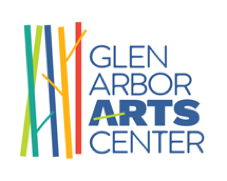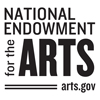
Creativity Q+A with Shanny Brooke
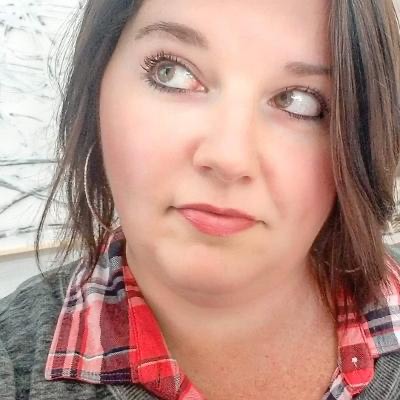
What is the medium in which you work.
Mostly oil [paint] and cold wax.
What does that mean?
A lot of people, right now, are interested in understanding the difference between encaustic and cold wax painting. 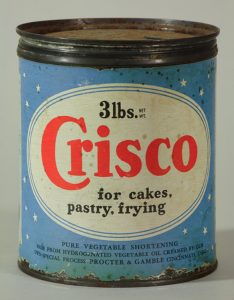 Cold wax [medium], I like to tell people, is more about consistency. When you get a new jug of cold wax, it kind of looks like Crisco …. It’s like softened butter. You add it to your oil paint. You can increase the translucency, the transparency of the oil paint with it depending on how much you add. Some artists put it right on top of [the painting]. There’s all kinds of uses for it … I use a palette knife. That’s the best way to use anything with cold wax. You could use a brush, but it tends to gum up the brush.
Cold wax [medium], I like to tell people, is more about consistency. When you get a new jug of cold wax, it kind of looks like Crisco …. It’s like softened butter. You add it to your oil paint. You can increase the translucency, the transparency of the oil paint with it depending on how much you add. Some artists put it right on top of [the painting]. There’s all kinds of uses for it … I use a palette knife. That’s the best way to use anything with cold wax. You could use a brush, but it tends to gum up the brush.
By using a palette knife, do you get a different appearance on the surface of the canvas?
I like things to be more textural. So, with a palette knife, you can really get that. You can cut into things more. I like things to be angular.
[NOTE: After the initial interview, when asked what she meant by cutting “into things more,” Shanny emailed this response: “Oil paint, (especially), when mixed with cold wax, develops a natural barrier between each layer. If I wait for the right amount of time, usually a few hours or sometimes overnight, I can use the tip of a pointy palette knife, or a clay tool, or any tipped object to carve away the newest layer to reveal what is underneath. Sometimes, if I want the under layers to be very ‘clean,’ I will go back over them with a Q Tip, which really gets all the paint residue off to allow the underneath to show through. I also like to make scratchy lines all around the subjects to create less perfection. I remember doing this in kindergarten, too, just while coloring. I think this is what I like most about the medium of oil and cold wax, is that the messier and less perfect a painting is, the more successful I consider it.”]
What draws you to the medium in which you work?
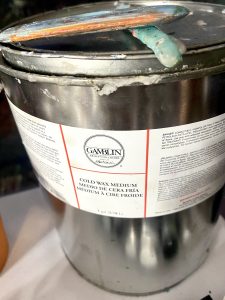
The fact that I can leave it for a long time and come back to it. I like to scrape things away and reveal what’s underneath certain colors. That’s easy to do with cold wax. That’s one of the things that draws me to cold wax. I never seem to have enough time to sit down and complete something. I work here at the gallery a lot, so I get interrupted a lot. I have to have that freedom to be able to come back to something.
It’s also interesting that you need time to think about your composition and the ideas in it.
Yes. For sure. As artists, we spend a lot of time working on a section or an area, then you leave it, go get a cup of coffee, come back and just stare at it. I’ll have my easel next to me here at my desk [in the gallery] and I’ll be answering emails or something, and keep looking at it. [Taking a pause] promotes more thought about what’s going to happen next.
Did you attend art school or receive any formal training in visual art?
No. I have not. I did go to art school, but for music. I was a classically trained singer, and never had any inclination to draw or paint. In fact, I was terrified of it. I never thought I’d be good at it. I graduated [in 1997] from Interlochen Arts Academy for voice. And then, I went to Peabody Conservatory in Baltimore [1998 – 2000] for voice for two years, and then I and dropped out. I have severe stage fright, debilitating … It was really bad. Once you get to the college level of classical music, everyone is amazing. You’re not the big fish in the little pond anymore. [Between] that horrible monster of comparing myself, and trying to be as good as everybody else, I couldn’t take the pressure.
How did you learn to paint?
I grew up as a kid in the restaurant industry. My dad owned a restaurant and he would always take me to work with him. I always loved to cook. When I lived in Florida, I started my own personal chef business. My dad lived here in Elk Rapids [Michigan], and he came up with this crazy idea that we were going open up a restaurant together, and we did [Regalo opened in 2008]. After a year-and-a-half of being really successful we realized having a business together was not a good idea for our relationship. I was super depressed. I’d left behind my business in South Florida, which was doing great. Left all my friends. Moved up here to Northern Michigan. Didn’t know anybody. This was in 2008. I just felt this urge I wanted to be creative in order to pull myself out of what felt like a huge loss. It was like a divorce. I just went to Michael’s and got a cheap pack of canvases and kid’s paints. I started doing little paintings, and everybody said, “Oh these are good. You should sell them!” I didn’t but I thought I really like this. It made me feel really good. Without sounding cliche, it really was the power of art that pulled me out of that hole I was in. Shortly after that I met my partner — whom I’m with now. And she’s a dog trainer, so we had dogs coming and going all the time. As an easy subject, I started painting her dogs that were always around. Her clients started asking me if they could pay me to paint their dog. That’s where it all started. I started doing these dog portraits, and it led to other things.
Describe your studio/work space.
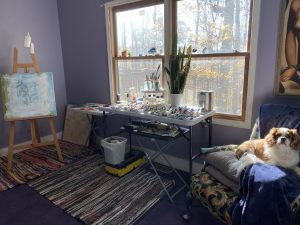
Right now my studio — I call it the nomadic studio. In the months that I’m really busy at [Higher Art Gallery], I can’t paint here. So, I have this little nook in my kitchen with windows. I put my canvas on the wall in the kitchen. Or, I use a little easel on a little table. It’s very cramped, it’s not ideal, but it works. When I’m here in the off season, I have all my paints in the office, and I have big easel I keep here next to the desk, and I just paint here at my desk. When people come in, we talk, and I just keep painting.
How does your studio/work space facilitate your work? Affect your work?
It affects me negatively and positively. I’ve learned how to work efficiently in a small space. I try to stay organized. I don’t have room to spread out and be messy — like I would love to do. Obviously, I can’t do that at the gallery. There’s [other people’s] art everywhere, and I have to stay neat and tidy. It gives me a feeling of restriction. One of the positive things is feeling like I’m forced to paint here while at work has helped me to get over my shyness. In order for me to produce art work, I have to be able to engage with people at the same time. They’re curious. They want to see what you’re working on. It doesn’t bother me anymore. At home working in that small nook in my kitchen — I hate working at home. I’m constantly being interrupted. And then I also feel the sense of, “Oh, I’m home. I’m going to wait for this spot [on the canvas] to dry, so I’m going to do some laundry,” and the next thing you know you’re tired and don’t want to continue with the painting. I’m hoping to have a designated space of my own soon.
When you talk about how your “studio” in your gallery affects your work, you said it has forced you to get over your shyness. Is that about having to engage with all the strangers who come through the front door?
I’m outgoing when it comes to that. My paintings go through this awful stage where they’re just bad and you don’t want anyone to see them yet. They’re going through this ugly duckling stage while you’re working on it. I’ve just had to get over that. I’ve just had to not worry about what someone is thinking while I’m working on a painting, while we’re chit-chatting. But I’ve found it’s a positive thing. When people walk into the gallery and see an artist working on something, it’s like an ice breaker. It relaxes people. It gives you an introduction, a way to talk to people. And then they ask if I have finished work in the gallery, and I can show them.
What themes/ideas are the focus of your work?
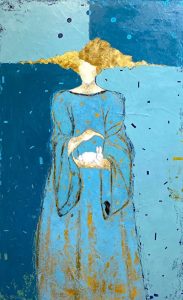
I’m an emotional person. I internalize a lot of stuff. I think getting my feelings out with a narrative on a canvas helps me work through my own stuff. Also, I’m a very nostalgic person. I had a close relationship with my grandmother. A very bad relationship with my mother. A lot of time, who and what I paint — my subjects — have a lot of of metaphor-slash-symbolism for these things. I tend to paint women because I’m in a relationship with a woman. My subjects tend to be two women. It’s what I relate to in life.
What prompts the beginning of a project or composition?
So many things. I’m literally surrounded by art all day every day. Sometimes it can be something as simple as one of my artists I represent brings in a piece, and I’m obsessed with the colors [they’re using]. I love looking around at the color combinations or composition of an abstract painting, and [then] apply it to a figurative painting. Lots of time I’ll start working on a figure with no real idea of where it’s going, and then a dog will come with it. I like painting birds. Women and birds. I paint a lot of women holding eggs. I went through this weird thing when I turned 40. I was like, “Oh god, I’ve haven’t had kids,” and so I painted a lot of women with eggs because I was feeling really weird about not having children. Was I regretting it? Not regretting it? It’s usually something deep-seated in me that has to come out.
How much pre-planning do you do in advance of beginning a new project or composition?
Now, in the last two year, I do a lot more than I used to do. I never ever, until two years ago, had a sketch book. It’s so ridiculous. Everything in my head, I’d just start on a canvas and finish it. Now, I do have a sketch book and try to sketch out ideas. I get annoyed when I forget them. That helps me practice for what’s going to be on the canvas. It was really always because I was afraid of drawing. I thought I would be so terrible at it. It actually turns out that I’m not that bad as I thought, and I really enjoy it. It’s relaxing. I plan things out loosely with a painting, and then, usually, other things will start to appear in the painting midway through.
Do you work on more than one project at a time?
No. I’ve tried. I get so jealous of artists who can have multiple things going on in their studio. I really have the ability to work on one thing at a time.
Do you work in a series?
I did when Michelle Tock York and I had that show over the summer, Heroines, Real And Imagined [August 5 – September 5, 2021 at Higher Art]. That was the first time I’d tried to discipline myself to work in a themed series. And, I didn’t like it. So, no. I don’t really. As I’m working other ideas come into my head and I no longer want to do this. I need a break from it. I just get bored.
What’s your favorite tool?
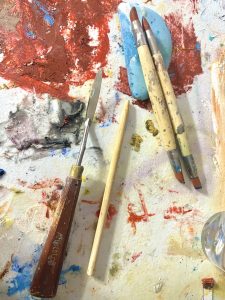
Palette knives. I use credit cards a lot to scrape. Those are good for wiping away paint to reveal what’s underneath. To get a really clean look [at what’s underneath] I use a lot of clay tools.
Why is making-by-hand important to you?
It’s important to me because I don’t know what else I could do that would alleviate this feeling I get inside when I’ve gone too long without using paint and doing something on a canvas. I get really irritable, and not in a good space when I haven’t made something with my hands.
Why does making things by-hand remain valuable to modern life?
Because we live in this society where everything needs to be done so quickly, and spit out so that people are happy. Making something by hand is so much more valuable because, well, it’s one-of-a-kind. And even if the artist makes multiples, it’s still one-of-a-kind because their hands have touched, and that leaves rooms for variations on what might appear to be the same thing. That’s one of the hardest things to get across to people when they’re trying to understand why something costs what it costs. Saying there is only one of something: When you think about it, it’s really pretty powerful when most people buy things now that there are millions of them.
How do you come up with a title?
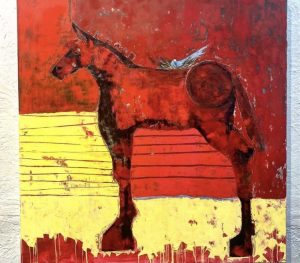
I love titles. Titles come a lot of times from a song. I used to keep a book in my purse because I’d hear something that was really smart, clever or touching, and I’d write it down and think that that would make a great title for a painting. Titles are usually pretty personal. I don’t love it when I see something titled “No. 20.” …… I understand why artists do it. I understand why you don’t want to explain to the viewer exactly what they should be thinking. And, you don’t always want to do that. I get it.
What’s the job of a title?
I think, for my paintings, people sometimes look at them and think they’re cutesy or whimsical — which I hate — or something like that. Yes. Sometimes I paint something just to paint it. Most of the time there’s some deeper metaphor in the painting, so I try to not make those metaphors so blatant. They’re a little hidden in the painting, and the title will allude to that
When did you commit to working with serious intent?
About five or six years ago.
What were the circumstances? What prompted that?
When I felt like I needed to [paint], having to do it for my well being.
What role does social media play in your practice?
It plays a big role. I do share a lot of things on social media [Instagram and Facebook]. In terms of the business side of selling my art, I do make sales using social media. It’s a love-hate relationship. I wish I didn’t have to use it. It’s a necessary evil …..
What’s its influence on the work you make?
It’s very convenient to have in your hand a virtual art gallery for the entire world. Almost every artist has social media. Or, if they don’t you can look at gallery accounts and then look at those artists. It’s inspiring. It does have an affect on me, and not just for looking at art, but for learning about new tools, new mediums. So many artists now post videos of themselves making their art. It’s a great way to learn new things.
What do you believe is the visual artist’s/creative practitioner’s role in the world?
On one hand, artists shouldn’t feel like they have to take on having a role. We’re just here to create what moves us, and if it can effect change or move other people in some way, then that’s great; but I don’t feel that that should be our role or responsibility.
What parts of the world find their way into your work?
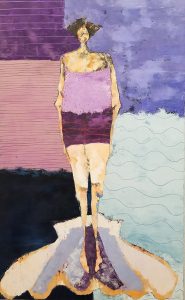
I think one of the reasons I paint women a lot is not only in response to what has been happening for the last five years. When Trump came into office, I felt like women were under attack all over again. That inspires me to focus more on women. In the smaller, microcosm of that, being a woman gallery owner I feel like I’m constantly questioned and tested by men, male artists and patrons who question my level of knowledge about what I’m doing with my business. I feel like everyday, on the smaller level, I have to face it here, too. I’m friends with other gallery owners in area who are women, and we get together and talk about this all time. It’s a real thing and starts to wear on you … I came in here a few weeks ago, and had a message on the gallery answering machine from a man who went on [such an extended] rant that the answering machine kept on cutting him off. He called back three times to finish his thought, which was all about how I’m on the wrong side of history because I’m choosing to represent mainly female artists; and that I’m part of the problem in this country of dividing men and women, and black and white. It was a really angry message. That was the blown-up version. But I deal with little comments all the time. It, honestly, makes my stance on this even stronger. Obviously there’s a problem if people feel these things, and feel a need to say these things. I’m not going to stop doing what I’m doing.
How does living in Northern Michigan inform and influence your creative practice?
It affects it greatly. I am somebody who’s affected lot by seasonal changes. I tend to paint accordingly. Living in Northern Michigan with the beauty that surrounds us around affects my painting. In the spring I paint outside, and those things will find their way into my paintings.
Is Northern Michigan reflected in the work you make?
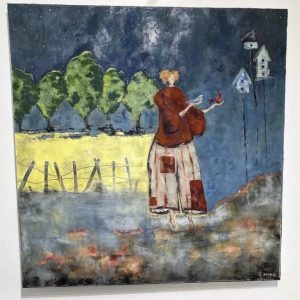
I notice that in the winter when I’m painting more, my paintings tend to be more introspective and quieter because it is quiet. I’m inside more. Definitely in the spring and summer, birds and nature will find their way into my paintings. If I’m home in the summer, I’ll try to paint on my front porch. We live in the woods so it’s easy to take that in, and it comes out in the work.
Would you be doing different work if you did not live in Northern Michigan? Would it have a different appearance?
I think so. For instance: I lived in South Florida for many years. You can look at [the work of an] artist who lives in South Florida, and know they live in South Florida. Oftentimes they use very different colors: a lot of turquoise, pink, and things like that. After I’ve gone to South Florida, I soak up the colors from around there, and I want to use them. I want to paint them.
Did you know any practicing studio artists when you were growing up?
No.
Who has had the greatest and most lasting influence on your work and practice?
Two people. My partner, Pam. We’ve been together almost since I started painting. I know people who are in relationships with someone who is not an artist, and their partner does not understand, does not give them the solitary time they need to make things, and it’s bad. I’m very lucky that she gives that time even though she doesn’t always understand it. She’s very encouraging, and has always encouraged me: from the artist standpoint to opening the gallery. I think who you’re sharing your life with is a huge component in what you’re able to accomplish.
From an inspirational standpoint, and as a huge muse for me, is my grandmother [Beverly]. Even though she wasn’t an artist I like to think she was an artist in her spirit. She collected art. She appreciated well-made, fine things, and she filled her home with them. Growing up, all that [sunk into] me. I spent a lot of time with her. When she was alive I was her only grandchild, so she poured it all into me. She was silly, and strange, and different stories she told me shaped the way I see the world today.
Where or to whom do you go when you need honest feedback about your work?
My friend Julie has the best eye for when something isn’t working. I always send her a picture of [a work in progress], and say, “What’s wrong with this?” She immediately will respond with what I need to do to fix it, and it always works.
What is the role of the exhibition in your practice?
It’s important to me. I only exhibit my work here and at Twisted Fish [in Elk Rapids]. Of course I hear all sorts of feedback when I’m sitting here in the gallery, and people are looking at a painting they have no idea is mine. I know some artists who hide their work away. And, they’re OK with that. I like to get my work out there. It’s one of the ways I can connect with people in a positive way. It always means so much to me when people look at my work and connect with it on a personal level, they see something in it that I intended it to mean or to be.
Why did you open a gallery?
How does your work — owning and running Higher Art Gallery — cross-pollinate with your studio practice?
The obvious thing: I show my work here. Sometimes somebody will ask if I have work here, and I say no. I lie [laughs]. I may be having a particularly vulnerable day.
What challenges does working outside the home present to your studio work?
A lot. One of the things someone told me before I opened the gallery is that I’ll never have enough time to work on my own art work, and that is 100 percent true. If there was just one thing I could change in my life, that would be to have more time for my own art work. Since I moved [the gallery from Union Street] to this location, it’s much busier now, even in the off season. In the old space be able to paint for an entire day, and maybe someone walk through the door if I were lucky. It’s not like that any more.
See more of Shanny Brooke’s work here.
Sarah Bearup-Neal develops and curates Glen Arbor Arts Center exhibitions. She maintains a studio practice focused on fiber and collage.
